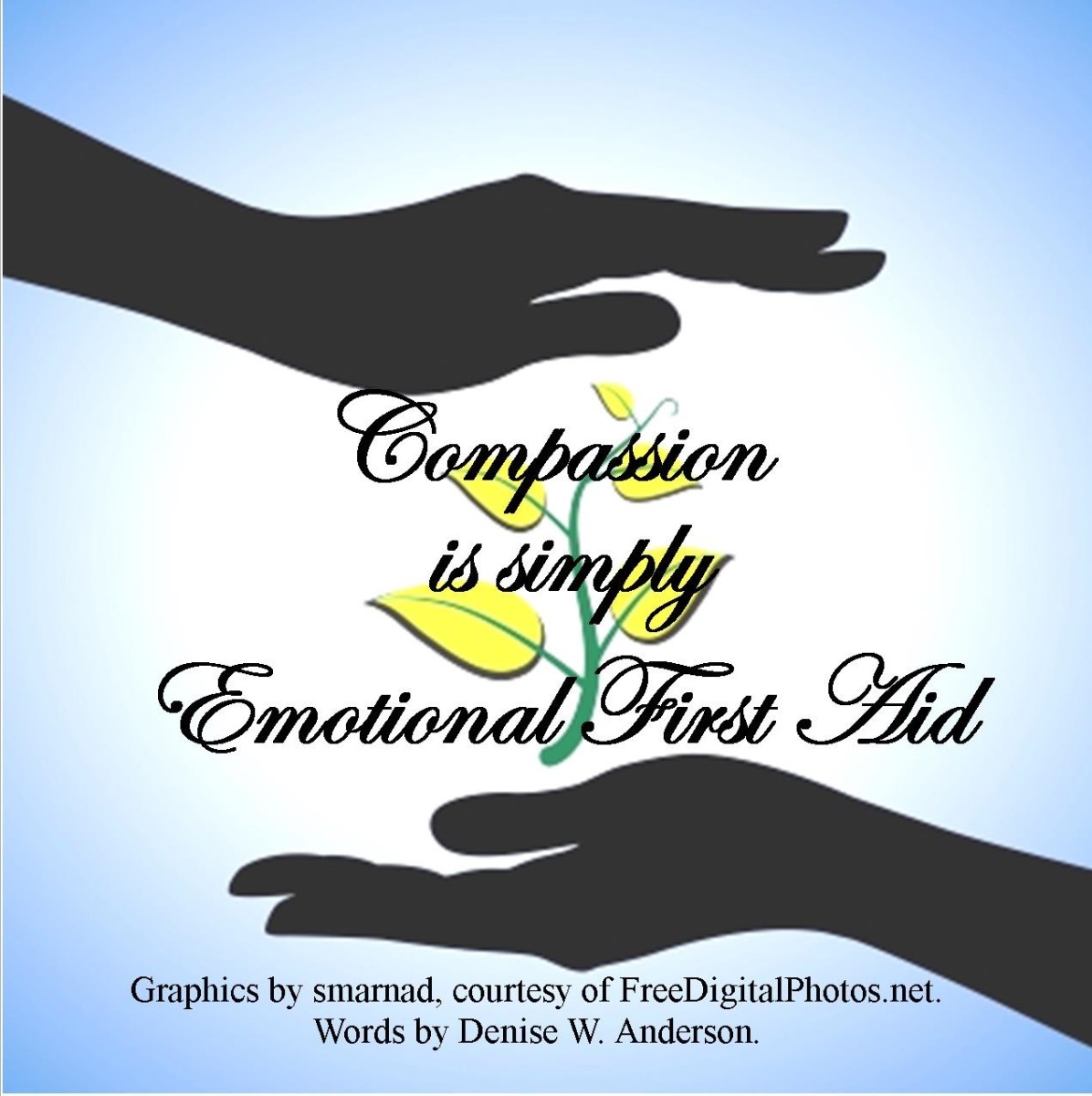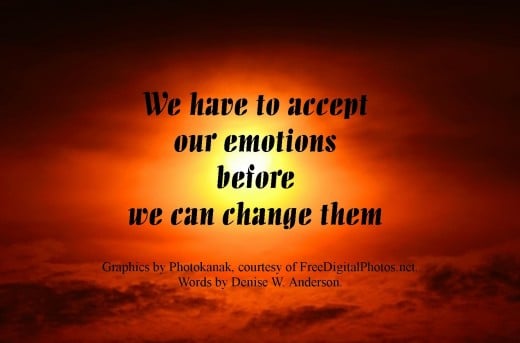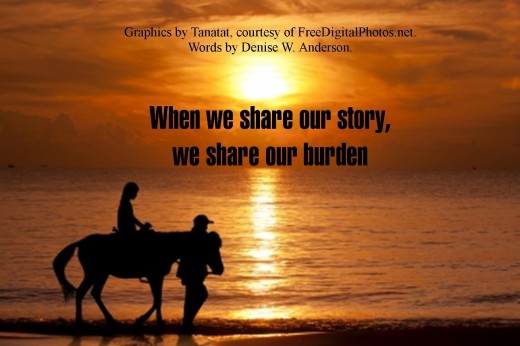Providing Emotional First Aid - Helping Others When They Are In Distress

The scene is a familiar one. Someone is quietly sobbing, their shoulders heaving as if their heart is breaking. We happen upon them at just the right moment to provide the needed assistance. But how do we do it? What can we say that will help the situation? Isn't it better to just turn around and walk away? What if we say something we shouldn't and just make it worse?
Feelings of inadequacy often accompany our desire to help and serve others. We know how we have felt in the past when someone has said something hurtful or stepped on our toes when we were emotionally distraught. We don't want to be the one in that position! Choosing to walk away might be the safest thing to do, but is it the right thing to do? Wouldn't walking away simply be saying, "I see you are hurting, but I don't want to get involved?"
Experience tells us that we want to help. We want to alleviate the pain and suffering that we see. It is a natural human emotion to show compassion when others are hurting. Emotional first aid is a little bit different than physical first aid, however, it takes more time and requires empathy and understanding. The following three step formula using the acronym AID provides us a guideline to follow:
- A - Acknowledge and accept the presenting emotion
- I - Invite the person to share their story
- D - Develop a viable plan of action
The paragraphs below explain this process and how it plays out in our lives.
"Kindness is powerful, especially in a family setting."
— Dallin H. OaksA - Acknowledge and accept the presenting emotion
Crying is a symptom of many emotions. It can be the result of sadness, anger, frustration, or simply a sign of emotional pain. The best way to approach someone that is crying is to get on their level, and say, "I see that you are upset." The response given indicates whether the person is willing to allow us to help them.
If the person lashes out in response, it usually means that there is anger and frustration. Once we receive this response, we can continue by saying, "It sounds like you are feeling angry." If the person backs down, and acknowledges the feelings, then we most likely have found the emotion that they are experiencing.
A "leave me alone" response is a signal that the person is not ready to work through their feelings. At this point, we may want to offer a different type of assistance, such as physical comfort. We can offer warmth, water, of food. Sometimes, alleviating physical discomfort will warm the person's heart enough that they allow us to help them resolve their difficult feelings.
How often do you find yourself in a position to provide emotional first aid?
People who are grieving experience a wide variety of emotions including anger, sadness, fear, and hatred. The person may feel that they are on an emotional roller-coaster and want to get off. They may not even know how to respond when assistance is offered. In these cases, it is best to look for some way to be helpful.
If the person is at home, and cleaning or dishes need to be done, roll up the sleeves and go to work. Perhaps the most valuable service we can provide is caring for their children while they take care of the problem situation.
If the person has not found the emotional center of their issues and they simply shake their head, we can stay with them and allow them to feel the depth of their emotion without being alone. Sharing small talk or reminiscing increases a sense that they are loved and accepted.
We would be wise to exercise caution when offering assistance to complete strangers, or people that we do not know well. If they are in emotional distress because they have overused their own support system to the point that others have turned their backs, there may be on ongoing long-term need that we cannot resolve.
People have been known to lie, cheat, and steal from others during crisis situations. If we do not feel comfortable assisting them, then walking away is the right thing to do. In any case, our goal is to provide temporary assistance and help the person develop a plan of action to take care of themselves.

I - Invite the person to tell their story
Everyone experiences emotional pain at some time in their lives. The events leading up to and surrounding the pain have significant personal meaning. Allowing them to tell their story helps resolve issues and move forward.
Much of our opportunity to lend a hand when someone is in distress come in the regular course of our everyday lives. Perhaps we notice someone at work that is dragging their feet or looking constantly at the floor. We may even happen upon someone while we are shopping that is visibly distressed.
We can tell that something is not right by the way they are walking or mumbling to themselves. Members of our own family may be in similar situations. Our ability to help the person depends upon our willingness to set aside what we are currently doing and actively listen.
Active listening has several steps:
- Show interest in what the person is experiencing
- Ask questions to get pertinent details
- Reflect feelings and understanding
- Validate the person's self-worth
Each time a person experiences distress, there is a reason for it. These feelings do not happen in a vacuum. What is distressing to one person may not be to another. Each person's understanding of life and their past will be different. Our ability to treat them as a valued human being while they are sharing their story increases their perception of their own worth.
We may have experienced something similar, or even worse, but the issue is not about us here. When someone is in distress, they rarely want to hear about what we did when we were in that situation! They are hurting, and in order to alleviate the pain, we need to hear their story without judgement or overbearance.
As we listen using the four steps listed above, we provide a framework to help the person share their experience in a way that is meaningful, thereby validating their feelings of self-worth. Once the emotional distress is alleviated, most people are able to put together a plan of action for their immediate future.

The Mountain*
I’m here at the foot of an uphill climb. It’s a long, steep trail, who’ll give me a line? What things will I need, will I have to pay? When will I get there, at the end of the day? Where are the tools I know I will need? Why am I here, is it fate or my greed?
When will others join in the climb? How can I go on alone this time? Who am I, thinking I am strong enough to climb a mountain so steep and rough? Who else will do it if I don’t go? Who else will make a trail marked so?
Who will be brave if I don’t pave the way? Who will go forward another day? Who will follow if I just lead? Who will step in and intercede? What am I doing out here all alone? What if I fall and break one of my bones?
What if there is no place to rest? What if I don’t make it, though I do my best? What will I do if I need some help? What if I just have to holler and yelp? What if a storm hits before I am there? What if I meet a lion or bear?
When will the next person be coming this way’? When will I know that I’ve gone the right way? When will the forest turn thick and black? When will I know that I must turn back? Where will I rest when I’m weary and sad? Where will I go when I’m feeling bad?
Where is the light I will need in the dark? Where is the trail that I should mark? Why am I climbing this mountain so steep? Why are you moving forward, my feet? Why am I determined to reach the top? Why am I compelled to go and not stop?
How am I strengthened with resolve so deep? How do my eyes on the summit keep? How is my strength like that of ten? How? Yes, my Savior is with me again!
D - Develop a plan of action
When the person is ready to move on past their story, they will begin to question what they should do. Our job as helpers is to facilitate the process, not guide it. There is a difference. When we facilitate, we reflect back what they are saying, helping them clarify and think it through. Guiding is giving direction in such a way that the outcome is what we want it to be rather than what they have determined for themselves.
In order for the person to buy into the plan of action, he or she must be the one to develop it. We can assist by asking open ended questions such as the following:
- What are you thinking about doing?
- What would happen if you did it?
- How would you feel?
- How would it affect your loved ones?
- What do you think would be the next step?
As we ask these types of open ended questions, we put the ball in the other person's court. They come up with the plan that will work for them. It needs to be simple enough that they see themselves successfully accomplishing it.
Our job as a helper is to give encouragement. When we let them know that we believe in them, and that they are fully capable of carrying out the plan, we give them an increased sense of self-worth.
We are providing the assistance that the Savior would provide if He were here. Our actions as His disciples bring joy and happiness into our lives and in the lives of those that we assist. Both are uplifted and strengthened.
When we find others who are in emotional distress, it is only natural for us to step in and lend a helping hand. The key to our ability to assist is listening to The Voice of Truth as noted in the song by Casting Crowns (see the video above). We are each endowed with this gift at birth. It leads and guides our footsteps throughout our mortal journey.
When we experience difficulty, we lose track of this precious gift. The provision of emotional first aid allows The Voice of Truth to be established inside us once again through the compassionate action of another. The giver is guided to know what to do and say, enabling the one receiving to re-gain their perspective.
In essence, providing emotional first aid establishes emotional health in the life of the receiver, and reinforces it in our own.
*poem "The Mountain" by Denise W. Anderson.
This content is accurate and true to the best of the author’s knowledge and is not meant to substitute for formal and individualized advice from a qualified professional.
© 2014 Denise W Anderson








